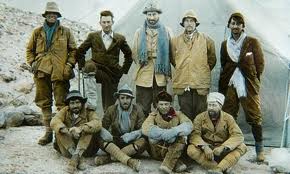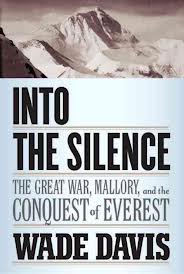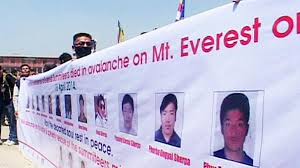
21 May Wade Davis at Mountainfilm 2014
Mountainfilm in Telluride proved to be a game-changer for Wade Davis, who joined the tribe in the mid-1990s. Now, on his more or less annual visits to town over Memorial Weekend, the man enjoys the status of a rock star, packing venues with his “groupies.” (I admit to being one of them.)
Priapic strutting is not part of Wade’s act. Nothing flashy at all. Just an understated eloquence around his subject that never fails to plug straight into the abiding energy system of the house.
Wade’s major presentation at Mountainfilm 2014 is part of a program at High Camp (Telluride Conference Center, Mountain Village) that takes place Sunday, May 25, noon – 2 p.m., when Wade and the iconic climber Conrad Anker celebrate “The 90th Anniversary of George Mallory’s Attempt on Everest.”
Few have spent more time trying to understand the mystery of Mallory and Everest than Anker and Wade. In fact Wade wrote the definitive book on the subject.
When Wade, a giant, looked back over his shoulder at Mallory, another giant, what he saw was a man with no choice: having emerged whole from the putrescent mud of WWI, the only place to turn was East and up. Everest became Mallory’s Grail, his Great White Whale, powerful, indifferent, ultimately healing in the chase, even unto death.
Into the Silence took Wade 10 years to pen, but with the release of this exhaustively researched project in 2011, he had climbed to new heights of acclaim:
“Into the Silence is quite unlike any other mountaineering book. It not only spins a gripping Boy’s Own yarn about the early British expeditions to Everest, but investigates how the carnage of the trenches bled into a desire for redemption at the top of the world. . . . At its heart, Into the Silence is an elegy for a lost generation . . . a magnificent, audacious venture,” The Sunday Times
“The book is not the only one on the subject, but it is the only one most of us will ever need. . . . In Into the Silence, he brings his talents as an ethnographer to bear in portraying the mostly British teams that led the expeditions (a Canadian and an Australian figured prominently as well). . . . Davis’s thorough research gives him an almost omniscient eye. He is as sure-footed a sherpa as we could have hoped for on this journey,” National Post
“Mr. Davis’s research is extraordinary, the scope of his book ambitious . . . , his writing sensitive and graceful, and the storytelling entertaining,” The Wall Street Journal
Wade is also schedule to speak at a Coffee & Conversation event on Saturday, May 24, 8 p.m., in the East Wing of the Ah Haa School for the Arts. His subject (also with Ben Ayers, Nepal country director for dZi Foundation; Aaron Huey, a photographer documenting Sherpas guise for National Geographic; and Norbu Tenzing, vice president of the American Himalayan Foundation and son of Tenzing Norbu) is “Nepal and the Money Train.”
Mountainfilm’s program describes the panel this way:
“The recent avalanche on Everest that killed 16 Sherpa guides has exposed major ethic and financial fissures at the top of the world. Four experts will discuss the role money plays in the mountains of Nepal…”
Wade frames that conversation in a recent article for Canada’s Globe and Mail.
“On June 7, 1922 George Mallory led 14 porters up the formidable face of the North Col of Everest. The air was still, with no wind. Suddenly the entire slope gave way, plunging seven Sherpas to their deaths. Expedition leader Charles Bruce later arranged compensation for the families. Each would receive 250 rupees, roughly £13 pounds.
On April 19, 2014 an avalanche in the notorious Khumbu ice field on the south side of Everest killed 16 Sherpas who had been fixing rope and carrying loads for the commercial parties. Each man earned $6000 a season, escorting foreigners who pay up to $100,000 for a chance to reach the summit. The Nepalese government, which takes in millions in fees, offered the families $415 in compensation, in buying power less than what the British dispersed nearly a century ago. Is it any wonder that 400 Sherpas walked off the job, shutting down every expedition on the eve of the climbing season, the narrow three-week window between winter and the onset of the monsoon?…
Surely it is time to invoke the spirit of Hillary and Tenzing and fully recognize the Sherpas as being equals on the mountain. They carry the weight of every expedition, confront the most terrible of hazards, and come to the rescue of every benighted party. Should they not receive the same compensation as every foreign guide? Should there not be trust funds set aside to assure every man that his family will be cared for in the event of his death? And why not insist that every climber on the mountain carries his or her own gear? This alone would reduce numbers, lessen the chances of death, and just perhaps return glory and integrity to a mountain that once stood as a lone sentinel in the sky, and a symbol of so much that was noble and true.”
Wade is also featured at a third talk, at Arroyo, Sunday at 5:30 p.m., part of Mountainfilm’s Booze & Banter get-together. The subject, roughly Wade on Wade (in other words, free form and pithy).
About Wade:
Wade is an Explorer-in-Residence at the National Geographic Society and man for all seasons: poet and scientist, ethnographer and photographer, filmmaker and licensed river guide. His primary focus has been on worldwide indigenous cultures, especially in North and South America, particularly involving the traditional uses and beliefs associated with psychoactive plants. Davis came to prominence with his 1985 best-selling book “The Serpent and the Rainbow” about the zombies of Haiti. He is the author of numerous other books, including “One River” and “The Sacred Headwaters: The Fight to Save the Stikine, Skeeba, and Nass.” Davis has lived and worked in the Stikine as a park ranger, guide, and anthropologist since 1978. He and his wife, Gail Percy, own Wolf Creek Lodge, the closest private holding to both the Sacred Headwaters.
To learn more about Wade and his upcoming Mountainfilm talk, click the “play” button and hear it in his own words.






Sorry, the comment form is closed at this time.